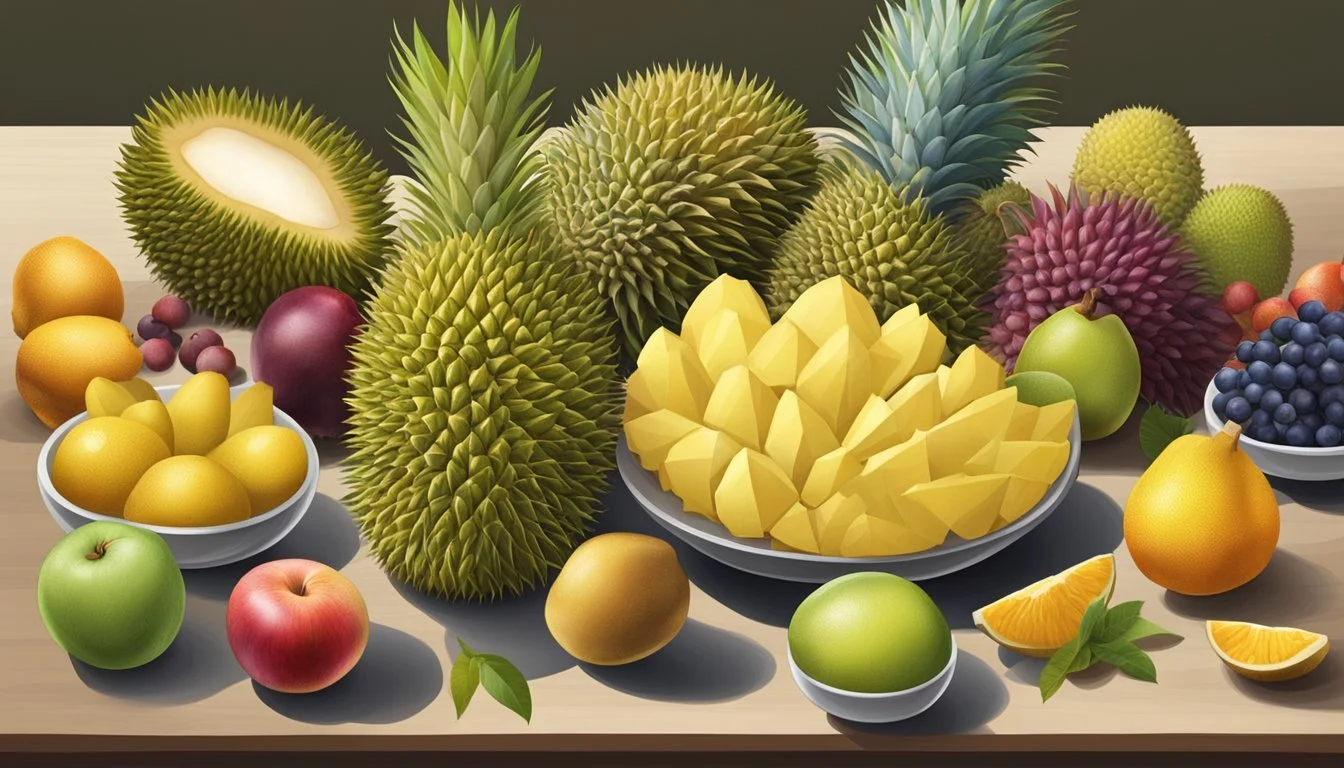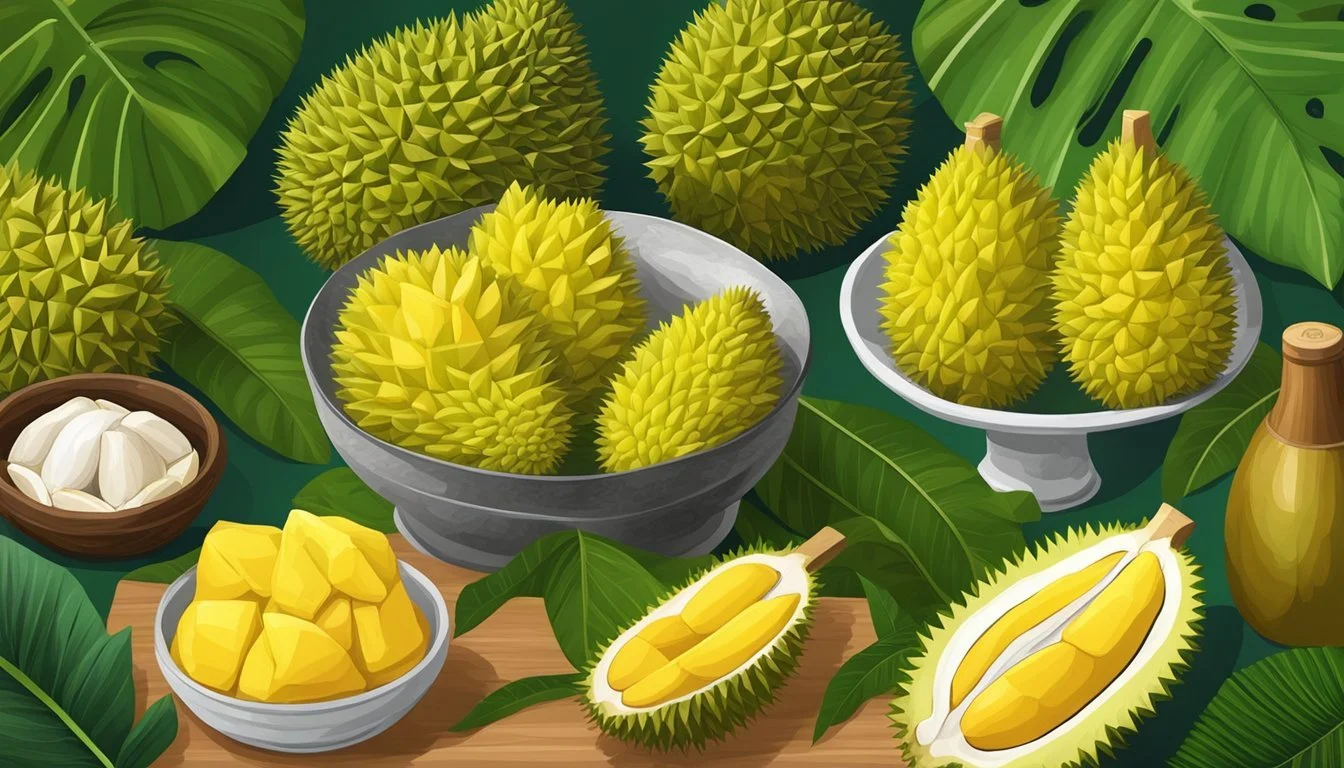Durian Substitutes
Best Alternatives Explained
Durian, known for its strong aroma and unique taste, is an exotic fruit that many find either irresistible or overwhelming. For those who are intrigued by durian's distinctive flavor but find its intensity too much, several delightful substitutes provide a more subtle experience. These alternatives allow individuals to enjoy the essence of durian without being overpowered by its smell and taste.
Jackfruit often emerges as a popular stand-in due to its similar texture and versatility in recipes. While durian boasts a creamy consistency, jackfruit offers a stringy and chewy texture, making it an excellent ingredient in both sweet and savory dishes. Additionally, jackfruit's milder flavor ensures that it can appeal to a broader audience while still delivering a tropical taste.
Another option includes durian-flavored products like ice creams, pastries, and candies that capture the fruit's essence without the strong odor. These adaptations offer a pleasant way to appreciate durian's unique qualities in a more approachable form.
Understanding Durian: The King of Fruits
The durian, often referred to as the "King of Fruits," is renowned for its unique flavor, rich nutrient content, and cultural significance. This section explores the origins, cultivation, physical characteristics, and sensory profile of this remarkable fruit.
Origin and Cultural Significance
Durian has a deep-rooted history in Southeast Asia, particularly in countries like Thailand, Malaysia, Indonesia, and the Philippines. Its reputation as the "King of Fruits" derives from its esteemed status in these regions. Durians are often featured in traditional ceremonies and culinary practices, indicating their cultural importance.
In Southeast Asian markets, durians can be found prominently displayed, often celebrated as symbols of abundance and prosperity. The fruit's significance extends beyond culinary uses, influencing local art, folklore, and traditional medicine.
Cultivation and Harvesting
Durian trees thrive in tropical climates with abundant sunlight and well-drained soils. Key cultivation practices include proper planting, fertilization, pruning, and pest management to maintain healthy trees. These trees often require protection from strong winds to prevent damage.
Fruiting occurs after about 4-5 years of growth, typically during the monsoon season. Harvesting is a delicate process; skilled workers check for subtle signs of ripeness, such as scent and gentle tapping sounds. The fruit is then carefully pried open to reveal the creamy, edible flesh.
Physical Description
The durian fruit is conspicuous for its large, robust size and thick, spiky husk, which can range in color from green to brown. Durians can grow up to 12 inches long and weigh as much as 7 pounds. The outer shell is thorn-covered, guarding the soft internal pulp.
Inside, the segments of yellow to red flesh encase large seeds. Each variety of durian manifests slight differences in size, color, and shape, but all share the distinguishing spiky rind and custard-like interior.
Sensory Profile
Durian is famed for its intricate sensory profile. The fruit emits a strong, pungent aroma that is divisive—some describe it as sweet and fragrant, while others find it overpowering and off-putting. This distinctive smell is due to sulfur compounds present in the flesh.
The taste is similarly complex, combining sweet, savory, and creamy notes. The texture is often compared to custard, with a rich, buttery feel that melts in the mouth. Durians deliver a burst of flavors ranging from caramel-like sweetness to subtle bitter undertones, making it a unique addition to any culinary experience.
Nutritional and Health Benefits
Durian is packed with a variety of essential nutrients and offers several potential health advantages. It is particularly rich in fiber, vitamins, and minerals that contribute to overall well-being.
Macro and Micro Nutrients
Durian is known for its dense nutritional profile, providing significant amounts of both macro and micro nutrients. One cup of chopped fresh or frozen durian (243g) provides approximately 357 calories, 3.6g of protein, 66g of carbohydrates, and 13g of fat. This makes it a high-calorie fruit ideal for energy.
Vitamins: Durian contains vitamins such as vitamin C, vitamin A, thiamin, riboflavin, niacin, and folate. Vitamin C supports immune function, while folate is crucial for cell division and DNA synthesis.
Minerals: Key minerals found in durian include potassium, magnesium, phosphorus, and copper. Potassium helps maintain fluid balance and muscle function, while magnesium supports nerve function and muscle relaxation.
Potential Health Properties
Durian’s nutritional components contribute to various health benefits. The dietary fiber in durian is beneficial for digestive health, promoting regular bowel movements and supporting gut bacteria.
Antioxidant Properties: Vitamins C and A act as antioxidants, helping to neutralize harmful free radicals in the body and reducing the risk of chronic diseases.
Anti-inflammatory Benefits: Some compounds in durian may exhibit anti-inflammatory properties, potentially aiding in reducing inflammation in the body.
Blood Sugar Regulation: The fiber content aids in slowing the absorption of sugar, which can help in managing blood sugar levels.
Durian's nutrient-rich profile makes it a valuable addition to a balanced diet, offering a comprehensive range of health benefits.
Culinary Uses of Durian
Durian, also known as the "king of fruits," is renowned for both its intense aroma and its creamy, custard-like texture. This tropical fruit from Southeast Asia is highly versatile and can be used in a variety of dishes, both traditional and modern.
Traditional and Modern Recipes
In traditional Southeast Asian cuisine, durian is a key ingredient in both sweet and savory dishes. In Malaysia, durian is used in pengat durian, a sweet soup made with coconut milk and palm sugar. Thailand features the fruit in sticky rice desserts, blending the unique durian flavor with glutinous rice and coconut cream.
Modern culinary uses of durian expand beyond traditional recipes. Chefs are incorporating durian into innovative dishes such as stuffed durian tacos or durian-flavored cheese. These contemporary recipes not only highlight the fruit's versatility but also offer a fresh take on traditional ingredients.
Durian-Based Products
Durian's rich, unique aroma and creamy texture make it an ideal candidate for various processed products. Durian ice cream is popular for its smooth texture and exotic flavor. It's available in both artisanal and commercial varieties, satisfying both the gourmet palate and casual consumers.
Other durian-based products include durian chips, which are a crispy, savory snack made from thinly sliced and fried durian pieces. Durian cake and pastries are also common, often featuring layers of durian paste or cream. These products help to preserve the fruit's distinctive taste while making it accessible in different formats.
Incorporating Durian into Dishes
Incorporating durian into everyday cooking can be an exciting culinary experience. Its sweet, pungent flavor pairs well with both savory and sweet preparations. For instance, using durian as a base in curries can add a creamy texture and a unique aroma to the dish.
In vegetarian dishes, durian can serve as a meat substitute due to its dense and fibrous texture. It is often added to salads for a tropical twist or blended into smoothies for a creamy consistency. Because of its strong flavor, it is essential to balance the dish with other ingredients to avoid overpowering flavors.
Cooking with durian can be a rewarding and adventurous experience, offering a unique twist to familiar recipes.
Selecting and Storing Durians
To enjoy durians at their best, it is crucial to know how to select a ripe fruit and store it properly. Preparation before consumption ensures the best flavor and texture.
Assessing Ripeness and Quality
When choosing a durian, consider the color and texture of the stem. A fresh stem indicates recent harvesting. A strong aroma often signifies ripeness, while a dull or flat scent may mean the fruit is unripe.
Look for a uniform color and slight cracks on the seams. These cracks can be a good sign, implying the durian is ready to open. Use your sense of touch—the flesh should have a slight give when pressed.
Proper Storage Methods
Durians are best stored at a temperature of 13-15°C (55-59°F). This prevents overripening and extends shelf life. Avoid temperatures below 10°C (50°F) as these can damage the fruit and alter its taste and texture.
Humidity levels matter too. High humidity can cause mold, while low humidity can dry out the flesh. Store durians in a cool, humid place, or use a refrigerator with proper settings. If freezing, durians should be sealed in an airtight container to preserve their aroma and flavor.
Preparation Tips Before Consumption
Before opening a durian, consider safety due to its thorny exterior. Use a thick cloth or gloves to handle it. Make an incision along one of the seams with a sharp knife, and pry it open gently.
Remove the large seeds from the creamy flesh. If you prefer a milder taste, you can refrigerate the flesh briefly before eating. Proper preparation techniques like these ensure you have the best possible experience when consuming durians.
Durian Substitutes
There are several viable alternatives to durian that offer unique flavors, textures, and applications in culinary practices. These substitutes can mimic the sensory experience of durian, whether you're seeking a similar taste, texture, or ease of use in various recipes.
Fruits with Comparable Qualities
Jackfruit is a popular durian substitute known for its large size and versatility. With a spiky green exterior, the interior reveals plump, yellow pods. When unripe, jackfruit's mild flavor and meaty texture make it excellent for savory dishes, such as pulled pork alternatives. Ripe jackfruit, on the other hand, offers a sweet flavor similar to a blend of apple, banana, and mango, suitable for desserts.
Chempedak is less known but a close botanical relative to jackfruit. It has a similar spiky exterior and sweet, sticky flesh. The texture is somewhat firmer than durian's custard-like consistency but still rich, making it a delightful addition to both savory curries and sweet desserts.
Other Substitute Recommendations
Avocado is a versatile option due to its creamy texture when mashed or pureed. Though it lacks the distinct flavor of durian, it can be incorporated into recipes that require a smooth, rich consistency, such as smoothies, ice creams, or spreads. It also offers nutritional benefits, being rich in healthy fats and fiber.
Pumpkin can act as an unusual but effective durian substitute in certain sweet dishes. When cooked and pureed, pumpkin provides a smooth texture and slightly sweet flavor, ideal for pies, custards, and baked goods. Adding spices like nutmeg or cinnamon can enhance its suitability for various recipes.
Adapting Recipes for Substitutes
When incorporating substitutes into traditional durian recipes, some adjustments are necessary. For durian cheesecake, using mashed avocado or pumpkin puree can yield a similar creamy consistency. Enhancing flavor with additional sweeteners or spices ensures the result is both enjoyable and reminiscent of the original dish.
In savory recipes, unripe jackfruit is a strong candidate for replacing durian. Cooking it with garlic, ginger, and tamari can create a flavorful base for dishes like curries or stir-fries. These adaptations require balancing the substitute's natural qualities to maintain an appealing taste and texture.
By thoughtfully selecting and preparing these substitutes, one can enjoy a range of both savory and sweet dishes reminiscent of durian without the strong aroma or polarizing taste. This approach also opens up culinary possibilities for those who might find durian itself too challenging.
Distinguishing Durian from Similar Fruits
Durian is often compared to other tropical fruits due to its unique characteristics, but several key factors set it apart. These differences include texture, aroma, appearance, and nutritional content.
Jackfruit vs. Durian: Understanding the Differences
Jackfruit is often mistaken for durian due to its large size and spiky exterior. However, the two fruits differ significantly in many aspects. Jackfruit is often larger than durian, with some specimens weighing up to 100 pounds. Durian, on the other hand, is renowned as the "smelliest fruit," with a pungent aroma that can be overwhelming.
In terms of texture, the flesh of jackfruit is stringy and fibrous. Durian, however, has a creamy and custard-like texture. When it comes to taste, jackfruit is typically sweet, resembling a combination of mango and pineapple. Durian's flavor is more complex, often described as a mix of sweet and savory notes.
Nutritionally, both fruits are powerhouses. Jackfruit is high in vitamins A, E, B5, and B6, while durian is rich in dietary fiber and vitamin C, making it more nutrient-dense in certain areas. The appearance of the tree and fruit placement also varies; durians grow on higher branches, while jackfruits are found lower on the tree.
Other Similar Tropical Fruits
Several other tropical fruits are often compared to durian in terms of appearance and taste. For example, the spiny cucumber can resemble a durian from the outside but lacks its strong smell and rich, creamy texture.
Soursop (or graviola) has a prickly exterior similar to durian but is notable for its softer, white flesh and sweet-tangy flavor. Mangosteen, though not spiky, is another tropical fruit often associated with durian. It has a hard, purple rind and sweet, juicy segments inside, markedly different from durian's custard-like consistency.
While these fruits share some visual similarities with durian, their flavor profiles and textures are distinct. They do not have the strong odor associated with durian, making them more approachable to some consumers. Each of these fruits offers its unique taste experience and should not be mistaken for one another.
The Socioeconomic Impact of Durian
The socioeconomic impact of durian in Southeast Asia is profound, influencing both regional economies and local communities. Key countries include Thailand, Malaysia, Indonesia, and the Philippines.
Durian Industry in Southeast Asia
The durian industry is a cornerstone of the agricultural economies in Southeast Asia. Thailand and Malaysia are the largest exporters, with Indonesia and the Philippines also contributing significantly.
Thailand's durian production has surged due to increasing demand in China. Farmers see high financial returns, resulting in extensive cultivation. Similarly, Malaysia is known for high-quality durians like Musang King and D24, making substantial contributions to the economy.
Durian trees thrive in the tropical climate of Southeast Asia, and the cultivation process involves substantial labor. This has led to job creation not only in farming but also in associated industries like transportation and retail. The fruit, often referred to as the "king of fruits", also boosts tourism, especially during durian festivals and tours, enhancing the region's culinary tourism.
Impact on Local Communities
Local communities benefit both economically and culturally from the durian industry. In Thailand and Malaysia, smallholder farmers rely heavily on durian cultivation for their livelihoods. The income generated supports local businesses and contributes to infrastructure development.
Culturally, the durian has significant importance. In these countries, durians are more than just a fruit; they are a part of the tradition and cuisine. Festivals celebrating durian harvests are common, fostering community spirit and attracting tourists.
However, there are challenges, such as environmental concerns linked to intensive farming practices. Sustainable cultivation practices are becoming crucial to mitigate negative impacts. Despite these challenges, the durian industry remains a vital part of local economies and social structures.







